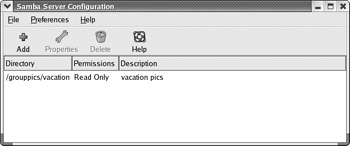Configuring the Samba with redhat-config-samba
|
| < Day Day Up > |
|
Red Hat now provides a simple configuration tool for providing basic information about your Samba server, as well as adding Samba users and specifying Samba shares (see Figure 37-1). You can start redhat-config-samba from the Samba entry in the Server Settings menu, accessible from the System Setting menu (or from the Server Settings window in the Start Here window's System Settings window). The redhat-config-samba tool will list all the shares for your server. You can use buttons at the top to manage your shares, adding new ones or deleting current ones. If you delete them, the actual directories are not removed; they just lose their status as shared directories. In Figure 37-1, a shared directory called /grouppic/vacation has been set up with read-only access.

Figure 37-1: redhat-config-samba
Server Configuration with redhat-config-samba
To configure your Samba server, select Server Settings from the Preferences menu. This opens a window with two panels, Basic and Security. On the Basic panel, you enter the Samba server workgroup name. On the Security panel, you specify the authentication mode, password encryption option, and the name of the guest account, along with the authentication server.
-
As explained in detail later, the authentication mode specifies the access level, which can be user, share, server, or domain. User-level access restricts access by user password, whereas share access opens access to any guest.
-
Normally, you would elect to encrypt passwords, rather than have them passed over your network in plain text.
-
The Guest user is the name of the account used to allow access to shares or printers that you want open to any user, without having to provide a password. The pop-up menu will list all your current users, with nobody as the selected default.
Adding Samba Users with redhat-config-samba
With redhat-config-samba, you can add users and shares easily. User-level access restricts users to those that also have accounts on the Samba server. Samba maintains its own password listing for users. To provide a user Samba access, you need to register the user as a Samba user. Select Samba Users from the Preferences menu to open the Samba Users window, clicking the Add User button. Here you enter the Unix Username, the Windows Username, and the Samba Password. There is an additional box for confirming the Samba password. The Unix Username is a pop-up window listing all the users on your Samba server.
Specifying Samba Shares with redhat-config-samba
Click Add to add a share, or select Add Share from the File menu. On the Basic panel, you can then enter the directory on the Samba server that you want to share, specifying the full pathname. The Browse button lets you search and select a directory. You can also set permissions to either read-only or read/write. On the Access panel, you can restrict access to certain users or allow access to all users. All Samba users on your system will be listed with check boxes where you can select those you want to give access.
|
| < Day Day Up > |
|
EAN: 2147483647
Pages: 328